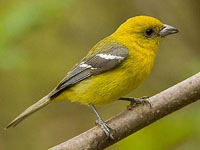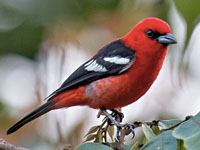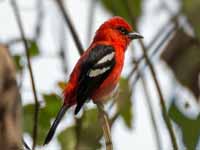THE WORLD BIRDS - An Online Bird Book
CARDINALIDAE
Cardinals and Allies
Order Passeriformes Family Cardinalidae
CARDINALIDAE
The Cardinalidae are a family of passerine birds found in North and South America. The family is comprised of buntings, cardinals, and grosbeaks. However, each of these categories
of birds have similary named birds in other families. The birds of this family are robust, seed-eating birds with strong bills. The family ranges in size from 12-25 cm. They are typically associated with
open woodland. The sexes are dimorphic - they usuaully have distinctive appearances.
Cardinals and Allies
Order Passeriformes Family Cardinalidae
Other Cardinal-like birds belong to Family Thraupidae.
Genus Cardinalis
Cardinal,_Northern Cardinalis cardinalis
Description: The male is bright red with a black face mask. The female has a grey mask and an olive-grey plumage with a reddish tinge on the upper-wings, tail, and crest. Northern cardinals have red conical bills.
Range: From south-eastern Canada, through the eastern United States to Central America. Introduced birds occur in regions outside the natural range.
Habitat: They occupy a wide range of habitats, including woodlands, woodland edges, forest clearings, shrublands, swamps, thickets, and suburban parks and gardens. Similar to: Vermilion Cardinal. Their ranges do not overlap.
Similar to: Phainopepla. Phainopepla does not closely resemble Cedar Waxwing except for its general shape.
Similar to: Pyrrhuloxia. Northern Cardinal has a pointed, orange to red bill, Pyrrhuloxia has rounded gray to yellow bill. Male Northern Cardinal has black mask, male Pyrrhuloxia has a red mask.
Consevation status: Least concern.
Image by: 1) Ehpien - Maryland 2, 3, 4, 5, 6, 7, 8, 9) Dick Daniels - North Carolina 10) Dick - Kawaii, Hawaii 11) Gary Mercier - Quebec cit 12) Andy_Morffew - TexasRange: From south-eastern Canada, through the eastern United States to Central America. Introduced birds occur in regions outside the natural range.
Habitat: They occupy a wide range of habitats, including woodlands, woodland edges, forest clearings, shrublands, swamps, thickets, and suburban parks and gardens. Similar to: Vermilion Cardinal. Their ranges do not overlap.
Similar to: Phainopepla. Phainopepla does not closely resemble Cedar Waxwing except for its general shape.
Similar to: Pyrrhuloxia. Northern Cardinal has a pointed, orange to red bill, Pyrrhuloxia has rounded gray to yellow bill. Male Northern Cardinal has black mask, male Pyrrhuloxia has a red mask.
Consevation status: Least concern.
1) Juvenile (black bill vs orange of adult) 2 - 6)) Female 6 - 12) Male

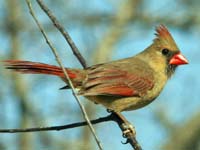
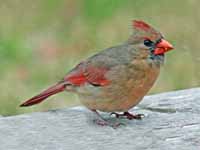
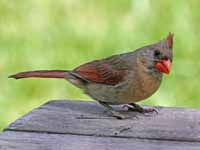
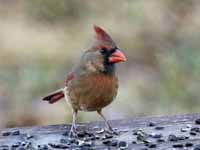

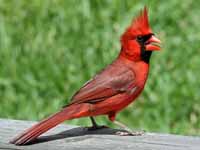
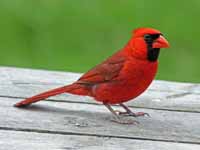
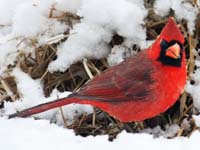
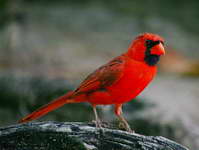

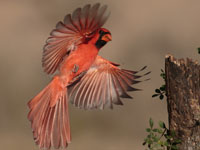
Cardinal,_Vermilion Cardinalis phoeniceus
Description: The male is vibrant red, and the female is grey above and pale buff below with a red crest. Vermilion cardinals have grey bills.
Range: Northern Venezuela and Columbia.
Habitat: Tropical and subtropical dry shrublands.
Similar to: Northern Cardinal. Their ranges do not overlap.
Consevation status: Least concern.
Image by: 1, 2) Cornell_Univ's_Neotropical_Birds_Online - Ken_Chamberlain, Eric_VanderWerf 3) Nick Athanas - Columbia 4) Mathdesm - Venezuela Range: Northern Venezuela and Columbia.
Habitat: Tropical and subtropical dry shrublands.
Similar to: Northern Cardinal. Their ranges do not overlap.
Consevation status: Least concern.
1) Female 2 - 4) Male
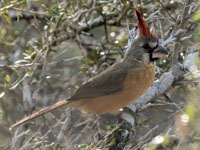
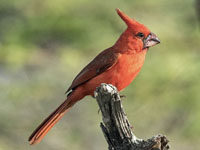
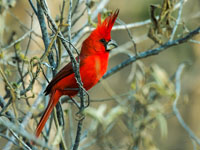
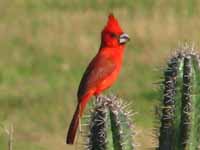
Pyrrhuloxia Cardinalis sinuatus
Description: The male is bright red with a black face mask. The female has a grey mask and an olive-grey plumage with a reddish tinge on the upper-wings, tail, and crest. Northern cardinals have red conical bills.
Range: From south-eastern Canada, through the eastern United States to Central America. Introduced birds occur in regions outside the natural range.
Habitat: They occupy a wide range of habitats, including woodlands, woodland edges, forest clearings, shrublands, swamps, thickets, and suburban parks and gardens.
Similar to: Northern Cardinal. Northern Cardinal has a pointed, orange to red bill, Pyrrhuloxia has rounded gray to yellow bill. Male Northern Cardinal has black mask, male Pyrrhuloxia has a red mask.
Consevation status: Least concern.
Image by: 1) Motorrad67 2) Jay Scratch 3, 4) Jerry Oldenettel - New Mexico 5) Dick Daniels - Tuscon, Arizona 2, 6) Andy_Morffew - Texas 7) Charley Westerinen - Agulia, Arizona 8) Evan Bornholtz - ArizonaRange: From south-eastern Canada, through the eastern United States to Central America. Introduced birds occur in regions outside the natural range.
Habitat: They occupy a wide range of habitats, including woodlands, woodland edges, forest clearings, shrublands, swamps, thickets, and suburban parks and gardens.
Similar to: Northern Cardinal. Northern Cardinal has a pointed, orange to red bill, Pyrrhuloxia has rounded gray to yellow bill. Male Northern Cardinal has black mask, male Pyrrhuloxia has a red mask.
Consevation status: Least concern.
1, 2, 3) Female 4) Nonbreding male 5 - 8) Breeding male
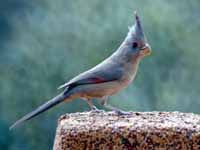
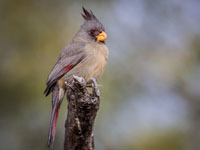
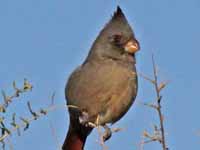
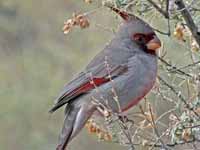

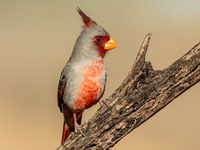
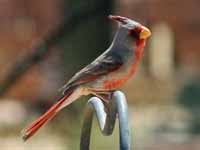
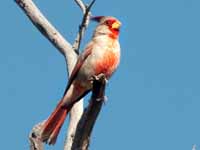
Genus Chlorothraupis
Birds of this genus were once members of the Thraupidae family along with the genera Habia and Piranga. They are closely related to the ant-tanagers of the Habia genus.
Tanager,_Lemon_Spectacled Chlorothraupis olivacea
Description: The male has a dark green plumage, whereas the female is a much lighter olive-green. Both sexes bear the characteristic yellow eye-rings.
Range: Colombia, Ecuador, and Panama.
Habitat: Understory of moist lowland forests and forest edges.
Consevation status: Least concern.
Image by: 1) Bonner zoologische Monographien 2, 3) Nick Athanas - ColumbiaRange: Colombia, Ecuador, and Panama.
Habitat: Understory of moist lowland forests and forest edges.
Consevation status: Least concern.
1) Female 2, 3) Male
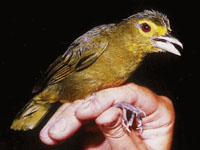
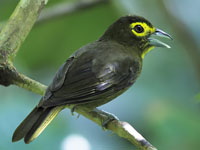
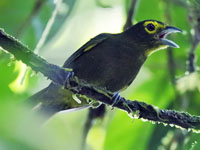
Tanager,_Ochre-breasted Chlorothraupis stolzmanni
Description: It has a dull olive-green plumage, and ochre underparts.
Range: From Columbia to Ecuador.
Habitat: Tropical and subtropical lowlands and montane forests.
Consevation status: Least concern.
Image by: 1) Michael Woodruff - Ecuador 2) Cornell_Univ's_Neotropical_Birds_Online - Peter_Lewis in Ecuador 3) Nick Athanas - EcuadorRange: From Columbia to Ecuador.
Habitat: Tropical and subtropical lowlands and montane forests.
Consevation status: Least concern.
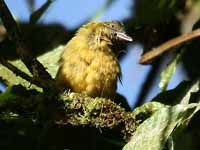
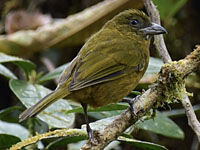

Tanager,_Olive also Carmiol's Tanager Chlorothraupis carmioli
Description: It is olive-green above and paler below with a yellow throat.
Range: Central America and northern South America.
Habitat: Tropical and subtropical moist lowland forests. They also occur in degraded former forests.
Consevation status: Populations are believed to be on the decline.
Image by: 1) Nick Athanas - Panama 2) Aaron_Maizlish - Panama 3) David Rodriguez - Costa Rica Range: Central America and northern South America.
Habitat: Tropical and subtropical moist lowland forests. They also occur in degraded former forests.
Consevation status: Populations are believed to be on the decline.
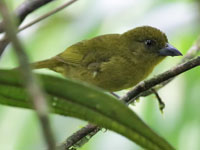
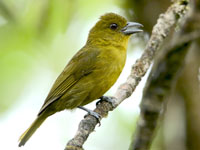
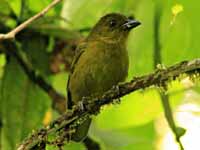
Genus Habia
The Habia genusis comprised of five species of ant-tanagers. They were included in the Thraupidae family before being placed in the Cardinalidae. Ant-tanagers have long tails and plumage that varies in shades of brown, yellow, red, and sooty black.
They are largely insectivorous. The name stems from their tendency to follow swarms of army ants to catch fleeing insects. Aside from insects, fruit makes up a small portion of their diet. They inhabit patches of dense, secondary woodlands.
Tanager,_Black-cheeked_Ant- Habia atrimaxillaris
Decription: It has dark brown upperparts and buff-colored underparts with a salmon-orange throat, which is brighter in males.
Range: Endemic to the Costa Rican Osa Peninsula.
Habitat: Tropical and subtropical moist lowland forests and shrublands.
Consevation status: Endangered
Image by: 1) David Rodriguez 2) Cornell_Univ's_Neotropical_Birds_Online - Chris_Morgan in Costa Rica 3) Nick Athanas Range: Endemic to the Costa Rican Osa Peninsula.
Habitat: Tropical and subtropical moist lowland forests and shrublands.
Consevation status: Endangered
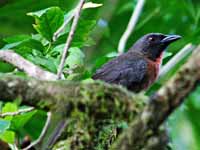
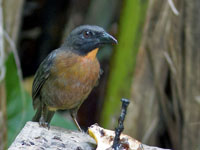

Tanager,_Crested Ant- Habia cristata
Description: A greyish-brown bird with a conspicuous red crest and a red head, neck, and upper breast. The female is similar to the male but has a smaller crest.
Range: Endemic to Columbia, where it inhabits the western slopes of the Andes.
Habitat: Tropical and subtropical moist lowland and montane forests.
Consevation status: Least concern.
Image by: 1) Felix_Uribe - Columbia 2) Francesco Veronesi - Columbia Range: Endemic to Columbia, where it inhabits the western slopes of the Andes.
Habitat: Tropical and subtropical moist lowland and montane forests.
Consevation status: Least concern.
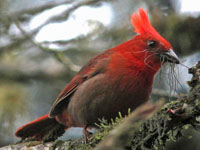
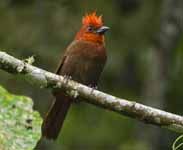
Tanager,_Red-crowned Ant- Habia rubica
Description: The male is dull red with a brighter red throat and breast. The female has a yellow-brown plumage with a brighter yellow throat. Both sexes bear the crown stripe, which is scarlet-red in males and yellow in females.
Range: From Mexico south to Paraguay and northern Argentina. They are also found in Trinidad.
Habitat: Tropical and subtropical forests and woodlands with a preference for the understory and dense forest floor.
Consevation status: Least concern.
Image by: 1) Dani e Iron 2) Claudio Timm 3, 4) Nick Athanas - Panama 5) Hector Bottai - BrazilRange: From Mexico south to Paraguay and northern Argentina. They are also found in Trinidad.
Habitat: Tropical and subtropical forests and woodlands with a preference for the understory and dense forest floor.
Consevation status: Least concern.
1, 2, 3) Female 4, 5) Male
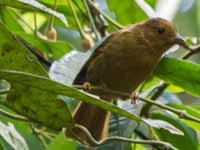
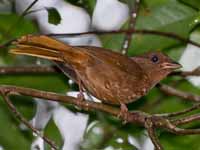
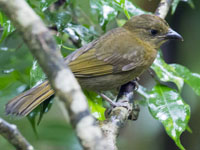
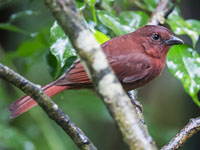
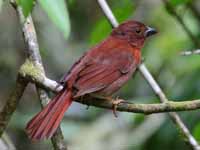
Tanager,_Red-throated Ant- Habia fuscicauda
Description: The male is dusky-red above and paler below with a characteristic bright red throat and crown. The female is brownish-olive above and pale-yellow below, with a bright yellow throat and dull yellow crown.
Range: South-eastern Mexico to eastern Panama.
Habitat: Woodlands, forest edges, secondary forest, and dense forest floors of tropical lowlands.The male Red-throated Ant-Tanager has dull dusky-red upperparts; paler underparts; bright red throat, central crown. Female has brownish-olive upperparts; paler and grayer underpartsyellow throat; small dull yellow crown stripe.
Consevation status: Least concern.
Image by: 1, 5) Cathy and Sam - Costa Rica 2) Nick Athanas - Panama 3) Jerry Oldenettel - Belize 4) Robert_Shea - Costa RicaRange: South-eastern Mexico to eastern Panama.
Habitat: Woodlands, forest edges, secondary forest, and dense forest floors of tropical lowlands.The male Red-throated Ant-Tanager has dull dusky-red upperparts; paler underparts; bright red throat, central crown. Female has brownish-olive upperparts; paler and grayer underpartsyellow throat; small dull yellow crown stripe.
Consevation status: Least concern.
1) Female 2, 3, 4) Male
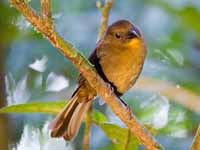

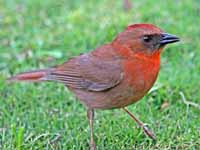
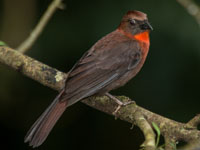
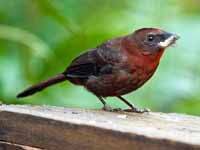
Tanager,_Sooty Ant- Habia gutturalis
Description: The male is dark grey with a bright scarlet crest throat patch. The female is similar but duller than the male.
Range: Endemic to North-west Columbia.
Habitat: Tropical and subtropical moist lowland forest, secondary forest.
Consevation status: Near-threatened
Image by: 1) Cornell_Univ's_Neotropical_Birds_Online - Peter_Hawrylyshyn 2) Nick AthanasRange: Endemic to North-west Columbia.
Habitat: Tropical and subtropical moist lowland forest, secondary forest.
Consevation status: Near-threatened
1, 2) Male
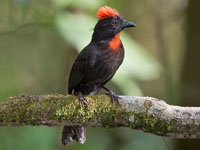
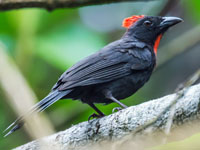
Genus Piranga
The Piranga genus was formerly included in the tanager family (Thraupidae) but was placed in Cardinalidae following DNA analysis. Birds in this genus are predominantly red, orange, or yellow with black wings and tails.
Tanager,_Flame-colored Piranga bidentata
Description: Flame-colored tanagers are named for the bright red coloration of the male’s plumage. The females are mostly yellow. Both sexes have black upperparts with white bands and distinctive ear-marks.
Range: From the southernmost United States through Central America to northern Panama.
Habitat: Mountain forests.
Similar to: Western Tanager. The ear marks of the Flame-colored Tanager differentiate it from the Western Tanager
Consevation status: Least concern.
Image by: 1, 2) Jerry Oldenettel - Costa Ricz 3) Dick Daniels - Boquette, Panama 4) Francesco Veronesi - Panama 5) Muchaxo - Costa RicaRange: From the southernmost United States through Central America to northern Panama.
Habitat: Mountain forests.
Similar to: Western Tanager. The ear marks of the Flame-colored Tanager differentiate it from the Western Tanager
Consevation status: Least concern.

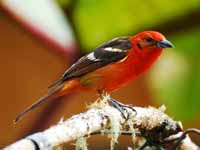


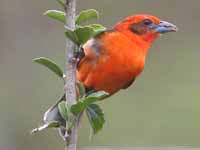
Tanager,_Hepatic Piranga flava
Description: The female hepatic tanager is yellow, and the male is red. Both sexes have greyish flanks and cheeks.
Range: From the Southwestern United States to Northern Argentina.
Habitat: Open woodlands, mixed forest, and forest edges.
Similar to: Summer Tanager. Female Summer Tanager has a longer, lighter colored bill than the female Hepatic Tanager. Male Summer Tanager is brighter red than male Hepatic Tanager.
Consevation status: Least concern.
Image by: 1, 4) Cláudio Timm - Cabo Polonio,
Uruguay 2) Jerry
Oldenettel - Costa Rica
3) Julian_Londono - Columbia 5) Elaine_Wilson 6) Kennedy_Andrade_Borges - BrazilRange: From the Southwestern United States to Northern Argentina.
Habitat: Open woodlands, mixed forest, and forest edges.
Similar to: Summer Tanager. Female Summer Tanager has a longer, lighter colored bill than the female Hepatic Tanager. Male Summer Tanager is brighter red than male Hepatic Tanager.
Consevation status: Least concern.
1, 2, 3) Female 4, 5, 6) Male
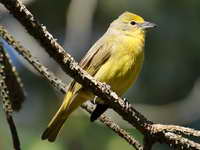
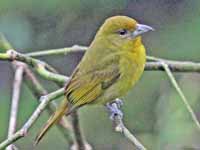

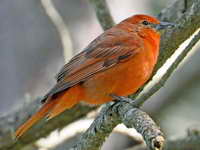
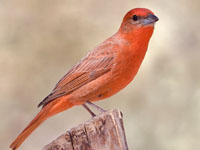

Tanager,_Red-headed Piranga erythrocephala
Description: The red-headed tanager is olive-green above and yellow below. It has a black eye-mask. The male has a bright red head and throat. The female is duller with grey cheeks and lacks the distinctive red.
Range: Western Mexico.
Habitat: Tropical and subtropical moist montane forests.
Consevation status: Least concern.
Image by: 1, 2) Cornell_Univ's_Neotropical_Birds_Online - Rolando_Chavez, Nigel_Voaden 3) Ron_Knight Range: Western Mexico.
Habitat: Tropical and subtropical moist montane forests.
Consevation status: Least concern.

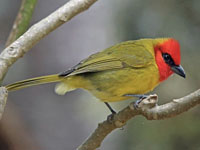
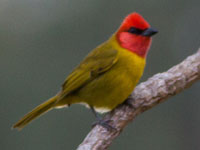
Tanager,_Red-hooded Piranga rubriceps
Description: It is a yellow bird with a crimson-red hood. The sexes are alike, but females are duller than males, and the red hood in males extends down the breast.
Range: They occur along the Andean mountain range from Columbia to Peru.
Habitat: Tropical and subtropical cloud and moist montane forests.
Consevation status: Least concern.
Image by: 1) Cornell_Univ's_Neotropical_Birds_Online - Juan_Ramirez_Rpo 2) Nick AthanasRange: They occur along the Andean mountain range from Columbia to Peru.
Habitat: Tropical and subtropical cloud and moist montane forests.
Consevation status: Least concern.
1) Female 2) Male
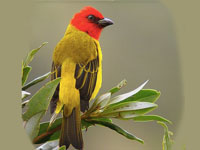

Tanager,_Rose-throated Piranga roseogularis
Description: The rose-throated tanager is mostly grey. It has a white eye-ring. The male has a reddish crown, upper wings, and tail, and a pinkish-red throat. Females are similar to males, with yellow in place of red.
Range: Their range encompasses Mexico, Belize, and Guatemala.
Habitat: Tropical or subtropical dry forests, woodlands, and forest edge. They also occur in degraded former forests.
Consevation status: Least concern.
Image by: 1) Cornell_Univ's_Neotropical_Birds_Online - Ian_Davies 2) Jorge Montejo - MexicoRange: Their range encompasses Mexico, Belize, and Guatemala.
Habitat: Tropical or subtropical dry forests, woodlands, and forest edge. They also occur in degraded former forests.
Consevation status: Least concern.
1, 2) Female
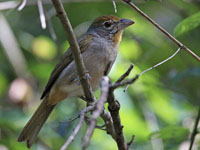
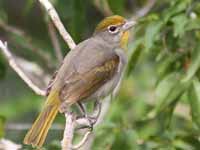
Tanager,_Scarlet Piranga olivacea
Description: The male is scarlet-red red with black wings and a black tail. The female is yellow with black and olive upperparts. Scarlet tanagers have smaller bills than other Cardinalidae members.
Range: They breed in eastern North America and winter in the northwest of South America.
Habitat: Deciduous forest, woodlands, and suburban gardens in summer and montane forests during winter.
Similar to: Summer Tanger. The male Scarlet Tanager has darker wings than the male Summer Tanager. The female Summer Tanager has a bigger bill than the female Scarlet Tanager.
Consevation status: Least concern.
Image by: 1) Kelly Colgan Azar 2) Jamie Chavez - California3, 4, 5) Jerry Oldenettel 6) Len Blumin - Florida 7) nebirdsplusRange: They breed in eastern North America and winter in the northwest of South America.
Habitat: Deciduous forest, woodlands, and suburban gardens in summer and montane forests during winter.
Similar to: Summer Tanger. The male Scarlet Tanager has darker wings than the male Summer Tanager. The female Summer Tanager has a bigger bill than the female Scarlet Tanager.
Consevation status: Least concern.
1) Juvenile or female 3) Nonbreeding male 4 - 7) Breeding male
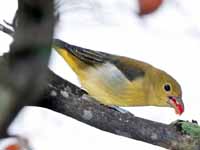

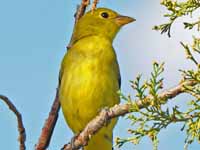
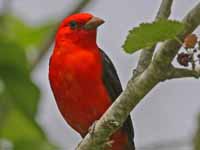
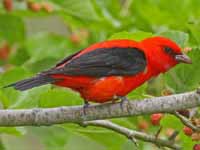
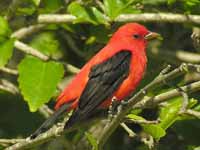
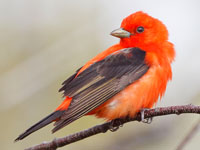
Tanager,_Summer Piranga rubra
Description: Males are crimson red, and females are dull yellow with orange splotches on the face, throat, and back.
Range: They breed in the Southern United States and migrate south for the winter to Mexico, Central America, and northern South America.
Habitat: In the breeding range, they nest in open woods and forests along streams. During winter, they inhabit lowland forests, forest edges, and clearings with scattered trees. Similar to: Hepatic Tanager. Female Summer Tanager has a longer, lighter colored bill than the female Hepatic Tanager. Male Summer Tanager is brighter red than male Hepatic Tanager.
Similar to: Scarlet Tanger. The male Scarlet Tanager has darker wings than the male Summer Tanager. The female Summer Tanager has a bigger bill than the female Scarlet Tanager.
Consevation status: Least concern.
Image by: 1) Paula McVann - Missouri 2) Pamela Wilson 3) Julian
Londono - Colombia 4) Andrej_Chudy - California 5) New Jersey Birds Range: They breed in the Southern United States and migrate south for the winter to Mexico, Central America, and northern South America.
Habitat: In the breeding range, they nest in open woods and forests along streams. During winter, they inhabit lowland forests, forest edges, and clearings with scattered trees. Similar to: Hepatic Tanager. Female Summer Tanager has a longer, lighter colored bill than the female Hepatic Tanager. Male Summer Tanager is brighter red than male Hepatic Tanager.
Similar to: Scarlet Tanger. The male Scarlet Tanager has darker wings than the male Summer Tanager. The female Summer Tanager has a bigger bill than the female Scarlet Tanager.
Consevation status: Least concern.
1, 2) Female 3, 4, 5) Male
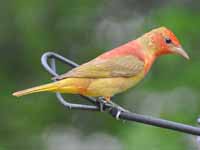
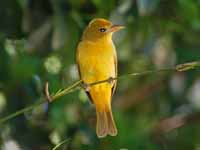
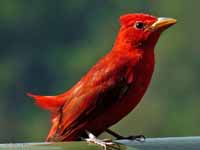
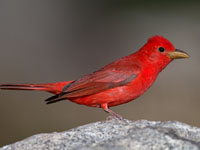
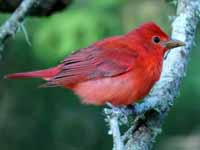
Tanager,_Western Piranga ludoviciana
Description: Both sexes are yellow. The male is brighter with a red face and black upperparts. In non-breeding males, the red is less prominent. The female has grey upperparts and lacks the distinctive red face.
Range: They are native to the western parts of North America, from Southern Canada and Alaska to Mexico. During winter, western tanagers migrate as far south as Panama.
Habitat: Coniferous forests and mixed woodlands in the breeding range. In their wintering areas, they occur in a wide range of habitats including grasslands, deserts, and suburban gardens. They also inhabit forest plantations and other cultivated lands.
Similar to: Flame-colored Tanager. The ear marks of the Flame-colored Tanager differentiate it from the Western Tanager
Consevation status: Least concern.
Image by: 1, 5) Elaine R Wilson - Oregon 2, 4) Alan D Wilson - Near Fort Rock, Oregon 3) Andrej_Chudy - CaliforniaRange: They are native to the western parts of North America, from Southern Canada and Alaska to Mexico. During winter, western tanagers migrate as far south as Panama.
Habitat: Coniferous forests and mixed woodlands in the breeding range. In their wintering areas, they occur in a wide range of habitats including grasslands, deserts, and suburban gardens. They also inhabit forest plantations and other cultivated lands.
Similar to: Flame-colored Tanager. The ear marks of the Flame-colored Tanager differentiate it from the Western Tanager
Consevation status: Least concern.
1, 2) Female 3, 4, 5) Male
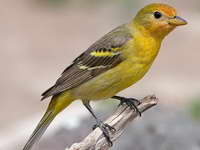
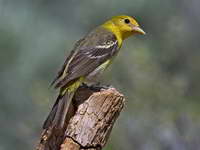
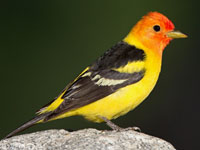
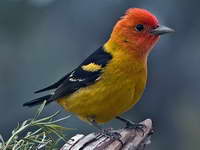

Tanager,_White-winged Piranga leucoptera
Description: The male is red with black wings. The female is yellow with duller wings. Both sexes have white wing bars.
Range: Their range spans Mexico, Central America, and South America.
Habitat: Tropical and subtropical moist lowland and montane forests.
Consevation status: Least concern.
Image by: 1, 2) Cornell_Univ's_Neotropical_Birds_Online - Antonio_Hidalgo in Mexico, Joao_Quental 3) Fernando Flores - Venezuela Range: Their range spans Mexico, Central America, and South America.
Habitat: Tropical and subtropical moist lowland and montane forests.
Consevation status: Least concern.
1) Female 2, 3) Male
